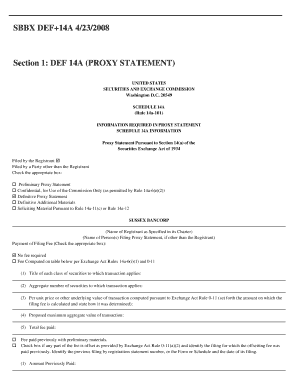Decoding The Proxy Statement (Form DEF 14A): Key Information And Analysis

Table of Contents
Understanding the Purpose of a Proxy Statement (Form DEF 14A)
The DEF 14A, formally known as a proxy statement, plays a vital role in corporate governance. It serves as a communication channel between a company's management and its shareholders, facilitating the democratic process of shareholder voting. This document is essential for shareholders to make informed decisions on matters put before them at the annual meeting or other shareholder meetings. Without a clear understanding of the DEF 14A, shareholders risk being uninformed participants in critical corporate decisions.
-
Provides information on shareholder proposals: Shareholders can submit proposals for consideration at the annual meeting. The DEF 14A details these proposals, allowing shareholders to understand the issues and vote accordingly. This includes social responsibility initiatives, changes to corporate governance, and other significant matters.
-
Details executive compensation and director nominations: The proxy statement provides a detailed breakdown of executive compensation, including salaries, bonuses, stock options, and other benefits. It also lists the nominees for the board of directors, giving shareholders insight into their backgrounds, qualifications, and potential conflicts of interest. This section is critical for assessing corporate governance and leadership.
-
Outlines voting procedures and deadlines: The DEF 14A clearly explains how to vote, whether by mail, online, or by proxy, and provides critical deadlines for submitting votes. Understanding these procedures ensures that shareholders can effectively exercise their voting rights.
-
Discloses significant corporate transactions: The document will disclose any material corporate transactions, such as mergers, acquisitions, divestitures, or significant capital expenditures. This allows shareholders to assess the potential impact of these transactions on the company's future.
Key Sections to Analyze in a DEF 14A Filing
The DEF 14A contains numerous sections, but some areas deserve particularly close scrutiny. Understanding these sections allows for a more thorough assessment of the company's financial health and corporate governance.
Executive Compensation
Analyzing executive pay packages is vital for assessing potential conflicts of interest and identifying excessive compensation. This section allows shareholders to compare executive compensation to industry benchmarks and gauge whether management is appropriately incentivized to maximize shareholder value.
-
Review salary and bonus details for top executives: Scrutinize the specific figures to identify any unusual patterns or discrepancies.
-
Analyze stock option grants and their potential impact: Understand the terms of stock options and their potential dilution effect on existing shares.
-
Identify any unusual or excessive compensation practices: Look for any instances of golden parachutes, excessive severance packages, or other forms of compensation that may not align with shareholder interests.
-
Compare executive compensation to industry benchmarks: Research compensation levels of similar companies to determine if a company's executive pay is justified.
Director Nominations and Elections
The director nominations section of the DEF 14A outlines the process of nominating and electing directors to the company’s board. Understanding this process is crucial for evaluating the board's composition and its ability to effectively oversee management.
-
Identify the nominated directors and their backgrounds: Evaluate the experience and qualifications of each nominee to determine if they possess the necessary skills and expertise to serve on the board.
-
Assess director independence from management: Ensure that a majority of the board is independent from management to prevent conflicts of interest. Look for any close ties between directors and management.
-
Review director compensation and other details: Understand the compensation structure for directors and determine if it's aligned with their responsibilities and the overall interests of the company.
Shareholder Proposals
Shareholder proposals offer an important avenue for shareholders to voice concerns and propose changes to company policy. Analyzing these proposals is critical for understanding shareholder sentiment and potential areas of concern.
-
Understand the nature and scope of each proposal: Clearly understand what each proposal is aiming to achieve.
-
Review the company's response to each proposal: Consider the management's rationale for supporting or opposing each proposal.
-
Assess the potential impact of each proposal on the company: Evaluate the potential financial and operational implications of each proposal’s adoption.
Significant Corporate Transactions
This section details any proposed mergers, acquisitions, or other major transactions. It's critical to understand the potential impact of these transactions on the company’s value.
-
Identify the nature and terms of any proposed transactions: Understand the details of the transaction, including the consideration offered and any contingent payments.
-
Assess the potential impact of the transaction on the company's financial health and future performance: Evaluate the deal's strategic rationale and its potential to enhance shareholder value.
-
Review any related party transactions: Scrutinize any transactions involving individuals or entities closely related to the company's management or board to identify potential conflicts of interest.
Analyzing the Proxy Statement for Informed Investment Decisions
Effectively utilizing the DEF 14A requires comparing its information to other public financial data. This cross-referencing helps verify information and identify potential inconsistencies.
-
Cross-reference information with financial statements (10-K, 10-Q): Compare the information presented in the proxy statement with other SEC filings, such as the 10-K and 10-Q reports, to ensure consistency and identify potential red flags.
-
Evaluate corporate governance practices: Assess the quality of the company's corporate governance by examining the independence of the board, the composition of its committees, and the company's adherence to best practices.
-
Identify potential conflicts of interest: Look for any instances where directors or executives may have personal interests that conflict with the interests of the company or its shareholders.
-
Look for signs of accounting irregularities: Pay close attention to the financial information presented in the proxy statement and compare it to other financial statements to identify any inconsistencies or potential accounting irregularities.
-
Consider the implications for long-term investment strategies: Use the information gleaned from the DEF 14A to inform your long-term investment decisions.
Conclusion
Successfully decoding a proxy statement (Form DEF 14A) requires careful review and analysis. By understanding the key sections and focusing on the details discussed above—executive compensation, director nominations, shareholder proposals, and significant corporate transactions—investors can make more informed decisions about their investments. Don't underestimate the power of a thorough review of the DEF 14A; it's a crucial tool for responsible investing. Start analyzing your next proxy statement (Form DEF 14A) today and empower yourself with the knowledge to make sound investment decisions.

Featured Posts
-
 The Disappeared Fortnite Skins Will They Ever Come Back
May 17, 2025
The Disappeared Fortnite Skins Will They Ever Come Back
May 17, 2025 -
 Bridges And Thibodeaus Public Dispute A Resolution
May 17, 2025
Bridges And Thibodeaus Public Dispute A Resolution
May 17, 2025 -
 Rockwell Automation And Other Top Performers Fuel Wednesdays Market Gains
May 17, 2025
Rockwell Automation And Other Top Performers Fuel Wednesdays Market Gains
May 17, 2025 -
 Is The Toronto Tempo Wnba Franchise Headed For Success Latest News Suggests Yes
May 17, 2025
Is The Toronto Tempo Wnba Franchise Headed For Success Latest News Suggests Yes
May 17, 2025 -
 2023 112
May 17, 2025
2023 112
May 17, 2025
